七年级英语下册语法大纲
初一下册英语语法归纳

初一下册英语语法归纳In the first half of the first year of junior high school, students will learn basic English grammar rules to help them form sentences and understand the structure of the English language.1. Parts of Speech- Nouns: People, places, things, or ideas.- Pronouns: Words used in place of nouns.- Verbs: Action or state of being.- Adjectives: Words that describe nouns.- Adverbs: Words that modify verbs, adjectives, or other adverbs.- Prepositions: Words that show the relationship betweena noun or pronoun and other words in a sentence.- Conjunctions: Words that connect words, phrases, or clauses.- Interjections: Words used to express strong emotion.2. Sentence Structure- A sentence must have a subject (the person or thing performing the action) and a predicate (the action or what is being said about the subject).- Sentences can be simple (one independent clause), compound (two independent clauses joined by a conjunction), complex (one independent clause and one or more dependent clauses), or compound-complex (two or more independent clauses and one or more dependent clauses).3. Verb Tenses- Present tense: Used to describe actions happening at the present time.- Past tense: Used to describe actions that have already happened.- Future tense: Used to describe actions that will happen in the future.- Present perfect tense: Used to describe actions that happened at an unspecified time before now.- Past perfect tense: Used to describe actions that happened before a certain point in the past.- Future perfect tense: Used to describe actions thatwill be completed at some point in the future.4. Subject-Verb Agreement- A singular subject takes a singular verb, while aplural subject takes a plural verb.- The consistency between the subject and the verb should be maintained throughout the sentence.5. Articles- "A" and "an" are indefinite articles used before singular nouns that are not specific.- "The" is a definite article used before singular or plural nouns that are specific or already mentioned.6. Modifiers- Adjectives and adverbs are used to provide more information about nouns and verbs, respectively. They should be placed close to the words they are modifying.By mastering these basic grammar rules, students will be able to form coherent and grammatically correct English sentences, which will lay a solid foundation for their future language learning.。
七下第二单元语法要点英语
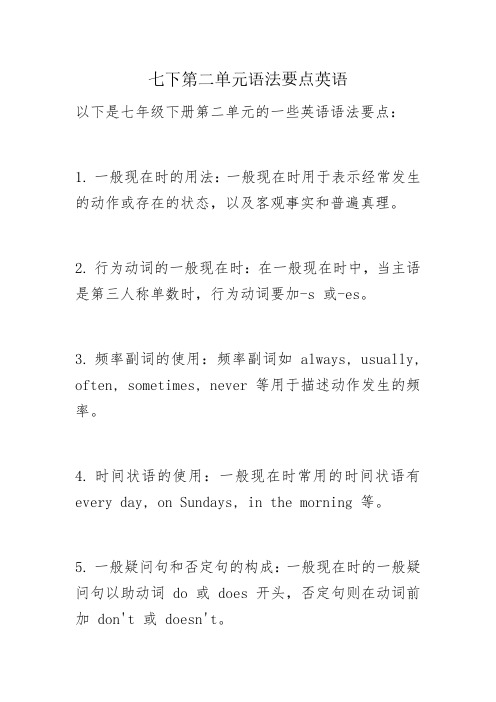
七下第二单元语法要点英语
以下是七年级下册第二单元的一些英语语法要点:
1.一般现在时的用法:一般现在时用于表示经常发生的动作或存在的状态,以及客观事实和普遍真理。
2.行为动词的一般现在时:在一般现在时中,当主语是第三人称单数时,行为动词要加-s或-es。
3.频率副词的使用:频率副词如always,usually, often,sometimes,never等用于描述动作发生的频率。
4.时间状语的使用:一般现在时常用的时间状语有every day,on Sundays,in the morning等。
5.一般疑问句和否定句的构成:一般现在时的一般疑问句以助动词do或does开头,否定句则在动词前加don't或doesn't。
6.介词的用法:介词用于表示时间、地点、方位等。
7.名词所有格的构成:名词所有格用于表示所属关系,通常在名词后加's。
8.形容词性物主代词的用法:形容词性物主代词用于修饰名词,起到限定作用。
这些是七年级下册第二单元的一些语法要点,希望对你有所帮助!。
人教版七年级下册英语期末复习:Unit 7-Unit 12 各单元语法知识点复习提纲(全面!)
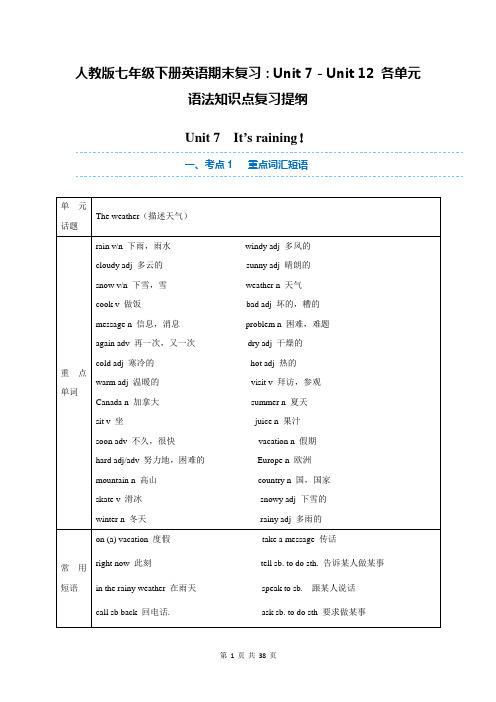
人教版七年级下册英语期末复习:Unit 7-Unit 12 各单元语法知识点复习提纲Unit 7 It’s raining!一、考点1 重点词汇短语1 messagemessage为可数名词,意为“消息,信息”,take a message for sb.“为某人捎个口信”。
拓展:give sb. a message 捎信给某人,leave a message 留口信,get the message 明白对方的意思。
Can I take a message for him?当某人发现要找的人不在或接电话的人发现打电话者要找的人不在时,常用此语2 could 情态动词意为“能,可以“,表示请求许可,在语气上比can委婉客气,但这种句式的肯定回答用can。
Could you just tell him to call me back?3 call及物动词,意为“打电话给”。
call sb. (up) “打电话给某人”,call sb. at +电话号码,意为“拨打……找某人”。
拓展:call 是一个多义词,call sb 可表示“叫醒某人,呼唤某人”;give sb. a call 给某人打电话。
4 back副词“回来,回原处,向后”;call sb. back给某人回个电话。
【即学即练】I’ll _____you _____.我将给你回电话。
5 visit此处用作及物动词,意为“拜访,探望”,后接表示人的名词或代词。
visit还可意为“参观,游览”,后接表示地点的名词。
拓展:visit还可用作可数名词,意为“访问,参观,拜访。
be on a visit to ... “正在访问/参观……”。
visitor参观者,游览者,游客。
I’m having a great time visiting my aunt in Canada._____ my grandparents every year at Christmas.我每年圣诞节都去探望我的祖父母。
七年级英语下册语法总结

七年级英语下册语法总结一、七年级下英语语法——词法1、名词A、名词的数我们知道名词可以分为可数名词和不可数名词,而不可数名词它没有复数形式,但可数名词却有单数和复数之分,复数的构成如下:一在后面加s;如:fathers, books, Americans, Germans, apples, bananas二x, sh, ch, s, tch后加es;如:boxes, glasses, dresses, watches, wishes, faxes三1以辅音字母加y结尾的变y为i再加es 如:baby-babies, family-families, duty-duties, comedy-comedies, documentary-documentaries, story-stories2以元音字母加y结尾的直接加s;如:day-days, boy-boys, toy-toys, key-keys, ways四以o结尾加s外来词;如:radios, photos, 但如是辅音加o的加es:如: tomatoes西红柿, potatoes马铃薯五以f或fe结尾的变f为v再加ess;如:knife-knives, wife-wives, half-halves, shelf-shelves, leaf-leaves, yourself-yourselves六单复数相同不变的有:fish, sheep, deer鹿子, Chinese, Japanese七一般只有复数,没有单数的有:people,pants, shorts, shoes, glasses, gloves, clothes, socks八单词形式不变,既可以是单数也可以是复数的有:police警察局,警察, class班,同学, family 家,家庭成员九合成的复数一般只加主要名词,多数为后一个单词;如:action movie-action movies, pen pal-pen pals; 但如果是由man或woman所组成的合成词的复数则同时为复数;如:man doctor-men doctors, woman teacher-women teachers十有的单复数意思不同;如:fish鱼fishes鱼的种类, paper纸papers报纸,卷子,论文, work 工作works作品,工厂, glass玻璃glasses玻璃杯,眼镜, orange桔子水oranges橙子, light 光线lights灯, people人peoples民族, time时间times时代, 次数, chicken 鸡肉chickens 小鸡十一单个字母的复数可以有两种形式直接加s或’s;如:Is I’s, Ks K’s;但如是缩略词则只加s;如:IDs, VCDs, SARs十二特殊形式的有:child-children, man-men, woman-women, foot-feet, mouse-mice, policeman-policemen, Englishman-EnglishmenB名词的格当我们要表示某人的什么东西或人时,我们就要使用所有格形式;构成如下:一单数在后面加’s;如:brother’s, Mike’s, teacher’s二复数以s结尾的直接在s后加’,如果不是以s结尾的与单数一样处理;如:Teachers’ Day 教师节, classmates’; Children’s Day六一节, Women’s Day三八节三由and并列的名词所有时,如果是共同所有同一人或物时,只加最后一个’s,但分别拥有时却分别按单数形式处理;如:Mike and Ben’s room迈克和本的房间共住一间,Mike’s and Ben’s rooms迈克和本的房间各自的房间2、代词项目人称代词物主代词指示代词反身代词人称主格宾格形容词名词性第一人称单数I me my mine myself复数we us our ours ourselves第二人称单数you you your yours yourself复数you you your yours yourselves第三人称单数she her her hers herselfhe him his his himselfit it its its this that itself复数they them their theirs these those themselves3、动词A 第三人称单数当动词是第三人称单数时,动词应该像名词的单数变动词那样加s,如下:一一般在词后加s;如:comes, spells, waits, talks, sees, dances, trains二在x, sh, ch, s, tch后加es;如:watches, washes, wishes, finishes三1以辅音字母加y结尾的变y为i再加es;如:study-studies, hurry-hurries, try-tries2以元音字母加y结尾的直接加s;如:plays, says, stays, enjoys, buys四以o结尾加es;如:does, goes五特殊的有:are-is, have-hasB 现在分词当我们说某人正在做什么事时,动词要使用分词形式,不能用原形,构成如下:一一般在后加ing;如:spell-spelling, sing-singing, see-seeing, train-training, play-playing, hurry-hurrying, watch-watching, go-going, do-doing二以不发音e的结尾的去掉e再加ing;如:dance-dancing, wake-waking, take-taking, practice-practicing, write-writing, have-having三以重读闭音节结尾且一个元音字母+一个辅音字母注意除开字母组合如show –showing, draw-drawing要双写最后的辅音字母再加ing;如:put-putting, run-running, get-getting,let-letting, begin-beginning四以ie结尾的变ie为y再加ing;如:tie-tying系die-dying死lie-lying 位于4、形容词的级我们在对两个或以上的人或物进行对比时,则要使用比较或最高级形式;构成如下:一一般在词后加er或est如果是以e结尾则直接加r或st;如:greater-greatest, shorter –shortest, taller –tallest, longer –longest, nicer- nicest, larger –largest二以重读闭音节结尾且1个元音字母+1个辅音字母字母组合除外,如few-fewer fewest结尾的双写结尾的辅音再加er /est;如:big-bigger biggest, red-redder reddest, hot-hotter hottest三以辅音字母+y结尾的变y为i加er/est;如:happy-happier happiest, sorry-sorrier sorriest, friendly-friendlier friendliestmore friendly most friendly, busy-busier busiest, easy-easier easiest四特殊情况:两好多坏,一少老远good/well - better best many/much - more most bad/ill –worse worstlittle- less least old- older/elder oldest/eldest far- farther/furtherfarthest/furthest5、数词基变序,有规则;一、二、三,自己背;五、八、九、十二;其它后接th;y结尾,变为i, eth跟上去; first, second, third; fifth, eighth, ninth, twelfth; seventh, tenth, thirteenth, hundredth; twenty-twentieth, forty-fortieth, ninety-ninetieth二、七年级英语语法——句式1.陈述句肯定陈述句a This is a book. be动词b He looks very young. 连系动词c I want a sweat like this. 实义动词d I can bring some things to school. 情态动词e There’s a computer on my desk. There be结构否定陈述句a These aren’t their books. b They don’t look nice.c Kate doesn’t go to No. 4 Middle School. d Kate can’t find her doll.e There isn’t a cat here. =There’s no cat here.2. 祈使句肯定祈使句a Please go and ask the man. b Let’s learn Englishc Come in, please.否定祈使句a Don’t be late. b Don’t hurry.3. 疑问句1 一般疑问句a Is Jim a student b Can I help you c Does she like salad d Do they watch TV e Is she reading 肯定回答: a Yes, he is. b Yes, you can. c Yes, she does. d Yes, they do. e Yes, she is.否定回答: a No, he isn’t. b No, you can’t. c No, she doesn’t. d No, they don’t. e No, she isn’t.2 选择疑问句Is the table big or small 回答It’s big./ It’s small.3 特殊疑问句①问年龄How old is Lucy She is twelve.②问种类What kind of movies do you like I like action movies and comedies.③问身体状况How is your uncle He is well/fine.④问方式How do/can you spell it L-double O-K.How do we contact you My e-mail address is cindyjones163.⑤问原因Why do you want to join the club⑥问时间What’s the time =What time is it It’s a quarter to ten a.m..What time do you usually get up, Rick At five o’clock.When do you want to go Let’s go at 7:00.⑦问地方Where’s my backpack It’s under the table.⑧问颜色What color are they They are light blue.What’s your favourite color It’s black.⑨问人物Who’s that It’s my sister.Who is the boy in blue My brother.Who isn’t at school Peter and Emma.Who are Lisa and Tim talking to⑩问东西What’s this/that in English It’s a pencil case.What else can you see in the picture I can see some broccoli, strawberries and hamburgers.11问姓名What’s your aunt’s name Her name is Helen./She’s Helen.What’s your first name My first name’s Ben.What’s your family name My family name’s Smith.12 问哪一个Which do you like I like one in the box.13 问字母What letter is it It’s big D/small f.14 问价格How much are these pants They’re 15 dollars.15 问电话号码What’s your phone number It’s 576-8349.16 问谓语动作What’s he doing He’s watching TV.17 问职业身份What do you do I’m a teacher.What’s your father He’s a doctor.三、七年级英语语法——时态1、一般现在时表示普遍、经常性的或长期性的动作时使用一般现在时,它有:Be 动词:She’s a worker. Is she a worker She isn’t a worker.情态动词:I can play the piano. Can you play the piano I can’t play the piano.行为动词:They want to eat some tomatoes. Do they want to eat any tomatoes They don’t want to eat any tomatoes.Gina has a nice watch. Does Gina have a nice watch Gina doesn’t have a watch.2、现在进行时表示动词在此时正在发生或进行就使用进行时态,结构为sb be v-ing sth + 其它.I’m playing baseball. Are you playing baseball I’m not playing baseball.Nancy is writing a letter. Is Nancy writing a letter Nancy isn’t writing a letter.They’re listening to the pop music. Are they listening the pop music They aren’t listening to the pop music.。
七年级英语下册语法大纲
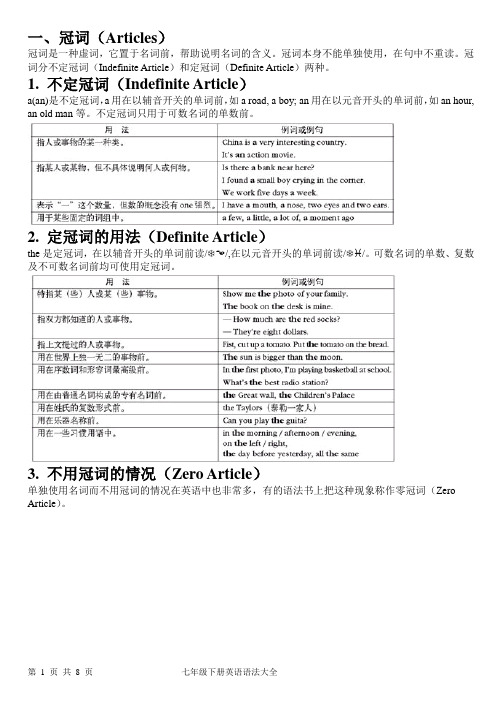
一、冠词(Articles)冠词是一种虚词,它置于名词前,帮助说明名词的含义。
冠词本身不能单独使用,在句中不重读。
冠词分不定冠词(Indefinite Article)和定冠词(Definite Article)两种。
1. 不定冠词(Indefinite Article)a(an)是不定冠词,a用在以辅音开关的单词前,如a road, a boy; an用在以元音开头的单词前,如an hour, an old man等。
不定冠词只用于可数名词的单数前。
2. 定冠词的用法(Definite Article)the是定冠词,在以辅音开头的单词前读/❆☜/,在以元音开头的单词前读/❆♓/。
可数名词的单数、复数及不可数名词前均可使用定冠词。
3. 不用冠词的情况(Zero Article)单独使用名词而不用冠词的情况在英语中也非常多,有的语法书上把这种现象称作零冠词(Zero Article)。
二、动词(Verbs)I. 现在进行时(The Present Progressive Tense)1) 表示现在(说话瞬间)正在进行或发生的动作。
也可表示当前一段时间内的活动或现阶段正在进行的动作。
例如:The students are listening to the teacher.He is watching TV now.现在进行时也可表示当前一段时间内的活动或现阶段正在进行的埈。
例如:We are working on a farm these days.I am writing a book this month.2) 现在进行时是由助动词be(am/ is/ are)加动词-ing形式构成的。
以动词work为例,现在进行时的肯定式、否定式、疑问式和简略答语如下:3) 动词-ing形式的构成:II. 一般过去时(The Simple Past Tense)1) 一般过去时表示过去某个时间发生的动作或存在的状态,常和表示过去的时间状语连用,如yesterday (morning, evening, afternoon), last night (week, summer, November), in 1990, (on December 16, 1948), two days/hours/months ago ,a moment ago等。
七年级下册英语1单元语法

七年级下册英语1单元语法
七年级下册英语1单元的语法重点主要包括现在进行时和be动词的用法。
现在进行时表示正在进行的动作或正在发生的事情。
其基本结构是“be动
词+动词的现在分词”,例如“I am writing a letter”表示我正在写一封信。
现在进行时通常与now、at the moment等时间状语连用,也可以表达计
划或安排将要发生的动作。
be动词是英语中最基本的动词之一,用于表示存在、状态或身份等。
其基
本形式包括am、is、are等,具体使用哪个形式需要根据主语的人称和数来决定。
例如,“I am a student”表示我是学生,“They are playing basketball”表示他们正在打篮球。
此外,be动词也可以与其他动词一起
构成被动语态,表示动作的接受者是动作的执行者。
除了这些基本用法外,七年级下册英语1单元还涉及到了一些扩展的语法点,例如形容词和副词的比较级和最高级、时间状语从句等。
这些知识点需要学生在学习过程中逐步掌握并加以应用。
精编七年级英语下册全部语法知识点总结
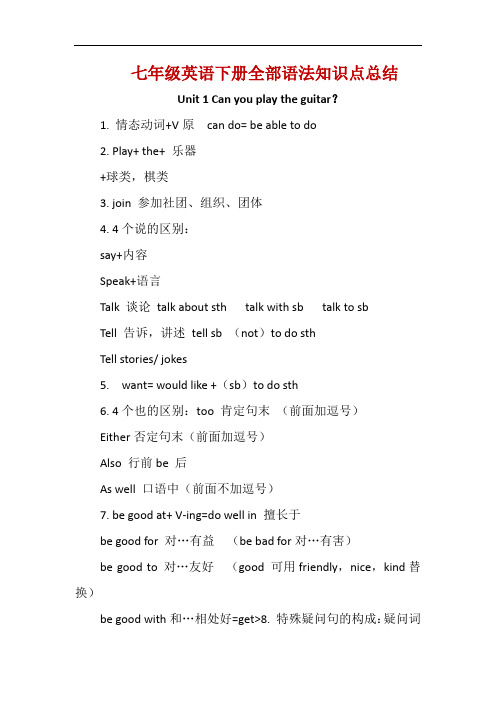
七年级英语下册全部语法知识点总结Unit 1 Can you play the guitar?1. 情态动词+V原can do= be able to do2. Play+ the+ 乐器+球类,棋类3. join 参加社团、组织、团体4. 4个说的区别:say+内容Speak+语言Talk 谈论talk about sth talk with sb talk to sbTell 告诉,讲述tell sb (not)to do sthTell stories/ jokes5. want= would like +(sb)to do sth6. 4个也的区别:too 肯定句末(前面加逗号)Either否定句末(前面加逗号)Also 行前be 后As well 口语中(前面不加逗号)7. be good at+ V-ing=do well in 擅长于be good for 对…有益(be bad for对…有害)be good to 对…友好(good 可用friendly,nice,kind替换)be good with和…相处好=get>8. 特殊疑问句的构成:疑问词+一般疑问句9. How/ what about+V-ing …怎么样?(表建议)10. 感官动词(look, sound, taste, smell, feel)+adj/ like11. 选择疑问句:回答不能直接用Yes或者No,要从中选择一个回答12. students wanted for school show(wanted表示招募,含有被动意义)13. show sth to sb=show sb sthgive sth to sb=give sb sth14. help sb (to)do sthHelp sb with sthWith sb’s help= with the help of sbHelp>15. be busy doing sth/ be busy with sth16. need to do sth17. be free= have time18. have friends= make friends19. call sb at +电话号码20.on the weekend= on weekends21. English-speaking students 说英语的学生(带有连词符,有形容词性质)22. do kung fu表演功夫Unit 2 What time do you go to school?1. 问时间用what time或者whenAt+钟点at 7 o’clockat noon/ at night(during/ in the day)On+ 具体某天、星期、特指的一天on April 1st on Sunday on a cold winter morning In +年、月、上午、下午、晚上2. 时间读法:顺读法逆读法:分钟≤30用pastfive past eight(8:05)half past eight(8:30)分钟>30用to a quarter to ten(9:45)整点用…o’clock 7 o’clock(7:00)3. 3个穿的区别:wear 表状态,接服装、手套、眼镜、香水等Put>Dress 表动作,接sb/>4. from…to…5. be/ arrive late for6. 频度副词(行前be后)Always usually often sometimesseldom hardly never7. 一段时间前面要用介词forfor half an hour for five minutes8. eat/ have…for breakfast/ lunch/ dinner/ supper9. either…or10. a lot of=lots of11. it is +adj+for sb +to do sth (adj修饰to do sth)It is important for me to learn English.it is +adj+of sb +to do sth (adj修饰sb)It is kind/ friendly/ nice of you to help me.12. 感叹句:How+adj+主谓!How+adj+a/an +n单+主谓!What+ a/an +adj+ n单+主谓!What+ adj+ n复/ 不可数+主谓!Unit 3 How do you get to school?1. 疑问词How 如何(方式)how long 多长(时间)答语常用“(For/ about +)时间段”how far多远(距离)答语常用“(It’s +)数词+miles/ meters/ kilometers”how often多久一次(频率)答语常用“Always/ often/ every day/…”或“次数+时间”等表频率的状语How soon多快,多久以后,常用在将来时中。
七下英语语法知识点归纳总结

七下英语语法知识点归纳总结以下是七下英语的部分语法知识点:1. 现在进行时定义:表示正在进行的动作或存在的状态。
结构:be (am/is/are) + 动词的现在分词。
动词现在分词形式:动词+ing,例如:playing, singing, 写作:writing。
用法:描述真实情境中的动作,例如“他正在看书”。
2. 动词不定式定义:动词不定式是非谓语动词的一种形式,表示不定或未来的动作。
结构:to + 动词原形,例如:to play, to go。
用法:作为目的状语、作为后置定语等。
3. 形容词的比较级和最高级定义:形容词的比较级表示“更……”,最高级表示“最……”。
结构:比较级:形容词+er,最高级:形容词+est。
用法:描述物品的大小、重量、长度等属性的比较,例如“这个苹果比那个大”。
4. 情态动词定义:情态动词是一种表示可能性、必要性的助动词。
结构:can, could, may, might, must等。
用法:表示可能性,例如“他可能在这儿”;表示必要性,例如“你必须快点儿”。
5. 一般将来时定义:表示未来的动作或状态。
结构:will + 动词原形,例如:will go, will be。
用法:描述未来的计划、安排等,例如“明天我将要去公园”。
6. 一般现在时定义:表示现在的动作或状态。
结构:动词原形,第三人称单数形式为动词+s/es。
用法:描述日常习惯、事实等,例如“我每天早上跑步”。
7. 现在完成时定义:表示过去的动作对现在的影响或过去的动作持续到现在。
结构:have/has + 过去分词。
用法:描述已经完成的动作或状态,例如“我已经完成了作业”。
8. 时间介词和连词表示时间的介词:at, on, in;before, after;since等。
表示时间的连词:when, while等。
用法:描述时间关系,例如“我在上学的时候去了北京”。
9. 宾语从句和定语从句宾语从句:放在动词或介词后面的句子,充当宾语。
七年级下册英语语法知识点归纳总结
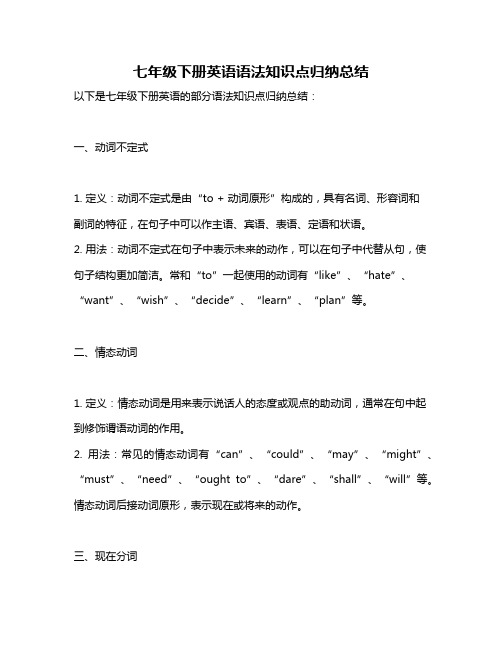
七年级下册英语语法知识点归纳总结以下是七年级下册英语的部分语法知识点归纳总结:一、动词不定式1. 定义:动词不定式是由“to + 动词原形”构成的,具有名词、形容词和副词的特征,在句子中可以作主语、宾语、表语、定语和状语。
2. 用法:动词不定式在句子中表示未来的动作,可以在句子中代替从句,使句子结构更加简洁。
常和“to”一起使用的动词有“like”、“hate”、“want”、“wish”、“decide”、“learn”、“plan”等。
二、情态动词1. 定义:情态动词是用来表示说话人的态度或观点的助动词,通常在句中起到修饰谓语动词的作用。
2. 用法:常见的情态动词有“can”、“could”、“may”、“might”、“must”、“need”、“ought to”、“dare”、“shall”、“will”等。
情态动词后接动词原形,表示现在或将来的动作。
三、现在分词1. 定义:现在分词是动词的一种形式,具有形容词的特征,可以表示正在进行的动作或状态。
2. 用法:现在分词可以作定语、表语和状语。
常和“-ing”一起使用的动词有“seeing”、“feeling”、“thinking”、“doing”、“being”等。
四、介词短语1. 定义:介词短语是由介词和名词或代词构成的短语,用来表示时间、地点、方式等。
2. 用法:介词短语在句子中可以作状语、定语和表语。
常见的介词有“in”、“on”、“at”、“for”、“with”、“by”等。
五、连词1. 定义:连词是用来连接两个句子或从句的词语,表示它们之间的关系。
2. 用法:常见的连词有“and”、“but”、“or”、“so”、“because”、“if”等。
连词在句子中起到承上启下的作用,使句子的意思更加清晰。
以上是七年级下册英语的部分语法知识点归纳总结,希望对你有所帮助。
人教版七年级下册英语Unit1-12语法总结
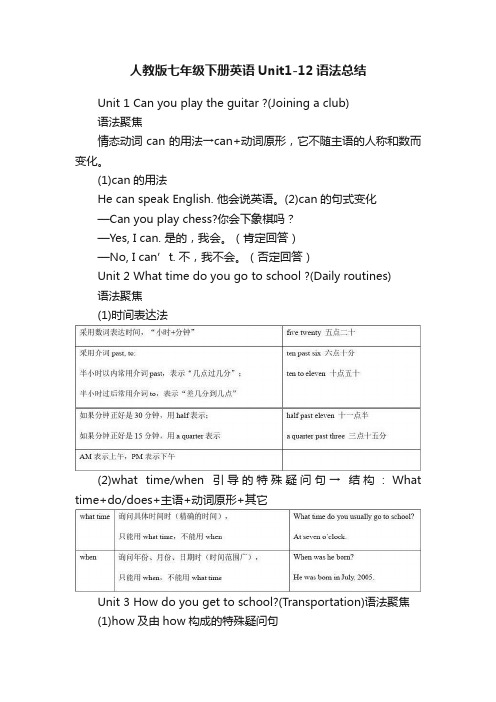
人教版七年级下册英语Unit1-12语法总结Unit 1 Can you play the guitar ?(Joining a club)语法聚焦情态动词can的用法→can+动词原形,它不随主语的人称和数而变化。
(1)can的用法He can speak English. 他会说英语。
(2)can的句式变化—Can you play chess?你会下象棋吗?—Yes, I can. 是的,我会。
(肯定回答)—No, I can’t. 不,我不会。
(否定回答)Unit 2 What time do you go to school ?(Daily routines)语法聚焦(1)时间表达法(2)what time/when引导的特殊疑问句→ 结构:What time+do/does+主语+动词原形+其它Unit 3 How do you get to school?(Transportation)语法聚焦(1)how及由how构成的特殊疑问句(2)how构成的其它特殊疑问词组how oldhow muchhow manyUnit 4 Don’t eat in class.(Rules)语法聚焦(1)祈使句:用来发出命令或指示,提出要求、建议、劝告等的句子(2)情态动词Unit 5 Why do you like pandas?(Animals in a zoo)语法聚焦(1)Why, what, where引导的特殊疑问句(2)拓展:becausebecause表示“因为”,so表示“所以”,但是两个句子不能同时出现在一个句子中,二者用其一即可。
例:Because I am free today,so I can go to the zoo. (×)I am free today,so I can go to the zoo. (√)Because I am free today, I can go to the zoo. (√)because后面要加句子,而because of 后面加名词(短语)、代词等。
人教版英语七年级下册各单元重要语法内容

一、动词的一般现在时人教版英语七年级下册的重要语法内容之一为动词的一般现在时。
在学习动词的一般现在时时,学生需要掌握动词的三单特殊变化规则,即在第三人称单数时,动词需要在词尾加上-s或-es。
学生还需要学习动词的否定形式和疑问形式的构成方法,以及常见的一般现在时的时间状语如often, usually, always等的用法。
二、名词的单数和复数形式另一个重要的语法内容是名词的单数和复数形式。
学生需要了解名词单数和复数形式的规则,掌握常见的名词复数变化规则,如在词尾加上-s, -es, -ies等。
学生还要熟练掌握一些不规则名词的复数形式,如man-men, woman-women等。
三、形容词的比较级和最高级形容词的比较级和最高级也是七年级下册的重要语法内容之一。
学生需要学习形容词比较级的构成方法以及常见的比较级形式,如比较级+than, more+形容词等。
学生还需要了解形容词最高级的构成方法以及常见的最高级形式,如the+形容词最高级, most+形容词等。
四、介词的基本用法介词是英语中一个重要的语法内容,学生需要掌握介词的基本用法,包括介词表示地点、时间、方向、原因等的用法,以及介词与动词、名词、形容词的搭配。
学生还需要学习一些常用介词的用法,如in, on, under, behind, between等。
五、情态动词情态动词是七年级下册的另一个重要语法内容。
学生需要了解情态动词can, could, may, might, must, shall, should, will, would等的用法和意义,并能正确运用这些情态动词进行句子的构成。
学生还需要学习情态动词的否定形式和疑问形式的构成方法。
六、并列连词和从属连词七年级下册还包括并列连词和从属连词的学习。
学生需要了解并掌握一些常见的并列连词如and, but, or等的用法,以及从属连词如because, when, if, although等的用法。
牛津译林版七年级下册英语Unit1-Unit8各单元语法知识点复习提纲详细版(全面,实用!)
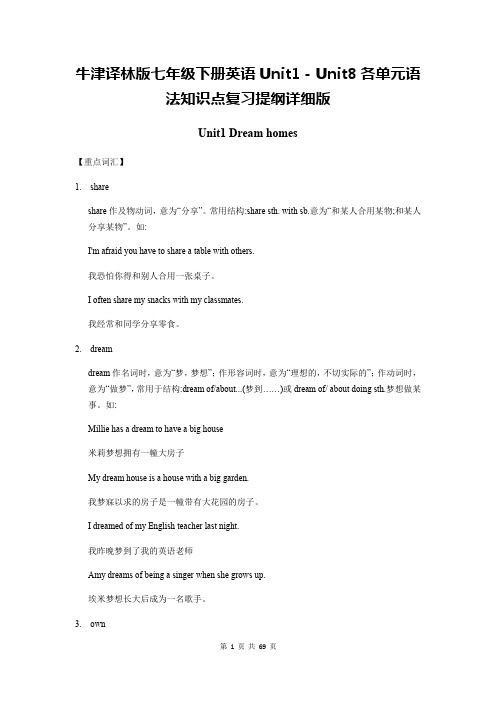
牛津译林版七年级下册英语Unit1-Unit8各单元语法知识点复习提纲详细版Unit1 Dream homes【重点词汇】1. shareshare作及物动词,意为“分享”。
常用结构:share sth. with sb.意为“和某人合用某物;和某人分享某物”。
如:I'm afraid you have to share a table with others.我恐怕你得和别人合用一张桌子。
I often share my snacks with my classmates.我经常和同学分享零食。
2. dreamdream作名词时,意为“梦,梦想”;作形容词时,意为“理想的,不切实际的”;作动词时,意为“做梦”,常用于结构:dream of/about...(梦到……)或dream of/ about doing sth.梦想做某事。
如:Millie has a dream to have a big house米莉梦想拥有一幢大房子My dream house is a house with a big garden.我梦寐以求的房子是一幢带有大花园的房子。
I dreamed of my English teacher last night.我昨晚梦到了我的英语老师Amy dreams of being a singer when she grows up.埃米梦想长大后成为一名歌手。
3. ownown作形容词.意为“自己的,属于自己的”,常和形容词性物主代词连用,构成短语of one's own,表示“属于某人自己的”,on one's own = alone,意为“独自地”。
own作动词时,表示“拥有”。
如:I have my own computer我有属于我自己的电脑。
That's a car of her own.那是她自己的汽车。
He lives on his own.他一个人生活。
七下英语语法归纳
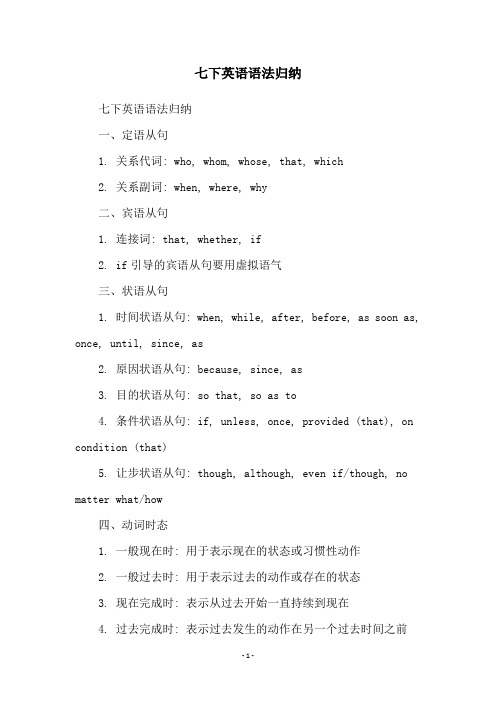
七下英语语法归纳
七下英语语法归纳
一、定语从句
1. 关系代词: who, whom, whose, that, which
2. 关系副词: when, where, why
二、宾语从句
1. 连接词: that, whether, if
2. if引导的宾语从句要用虚拟语气
三、状语从句
1. 时间状语从句: when, while, after, before, as soon as, once, until, since, as
2. 原因状语从句: because, since, as
3. 目的状语从句: so that, so as to
4. 条件状语从句: if, unless, once, provided (that), on condition (that)
5. 让步状语从句: though, although, even if/though, no matter what/how
四、动词时态
1. 一般现在时: 用于表示现在的状态或习惯性动作
2. 一般过去时: 用于表示过去的动作或存在的状态
3. 现在完成时: 表示从过去开始一直持续到现在
4. 过去完成时: 表示过去发生的动作在另一个过去时间之前
5. 现在进行时: 表示动作正在进行
6. 将来时: 表示将来发生的动作
7. 一般将来时: 表示将来会发生的动作或状态
8. 祈使句: 表示下达命令或表达愿望。
(完整版)七年级下册英语语法
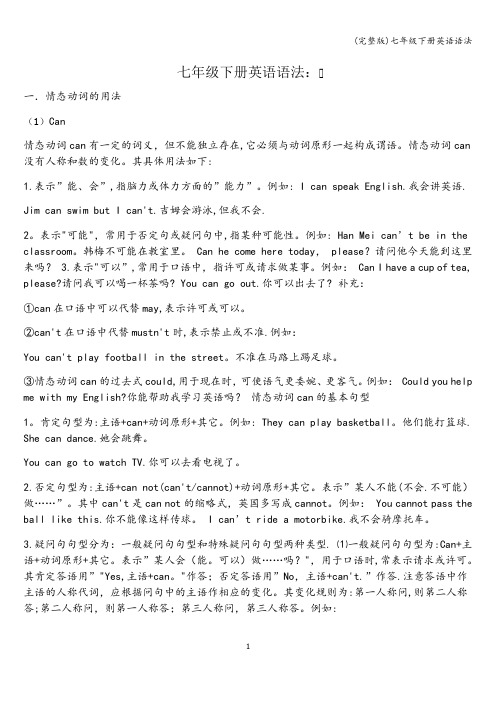
七年级下册英语语法:一.情态动词的用法(1)Can情态动词can有一定的词义,但不能独立存在,它必须与动词原形一起构成谓语。
情态动词can 没有人称和数的变化。
其具体用法如下:1.表示”能、会”,指脑力或体力方面的”能力”。
例如: I can speak English.我会讲英语.Jim can swim but I can't.吉姆会游泳,但我不会.2。
表示"可能",常用于否定句或疑问句中,指某种可能性。
例如: Han Mei can’t be in the classroom。
韩梅不可能在教室里。
Can he come here today, please?请问他今天能到这里来吗? 3.表示"可以”,常用于口语中,指许可或请求做某事。
例如: Can I have a cup of tea, please?请问我可以喝一杯茶吗? You can go out.你可以出去了? 补充:①can在口语中可以代替may,表示许可或可以。
②can't在口语中代替mustn't时,表示禁止或不准.例如:You can't play football in the street。
不准在马路上踢足球。
③情态动词can的过去式could,用于现在时,可使语气更委婉、更客气。
例如: Could you help me with my English?你能帮助我学习英语吗? 情态动词can的基本句型1。
肯定句型为:主语+can+动词原形+其它。
例如: They can play basketball。
他们能打篮球. She can dance.她会跳舞。
You can go to watch TV.你可以去看电视了。
2.否定句型为:主语+can not(can't/cannot)+动词原形+其它。
表示”某人不能(不会.不可能)做……”。
其中can't是can not的缩略式,英国多写成cannot。
七年级下册英语全部语法知识点
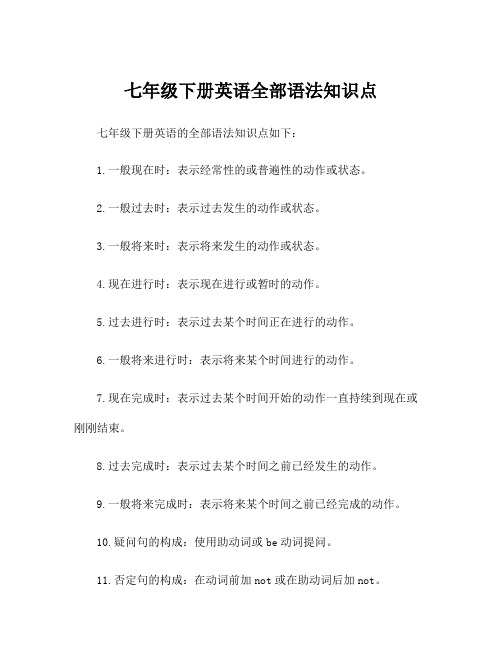
七年级下册英语全部语法知识点七年级下册英语的全部语法知识点如下:1.一般现在时:表示经常性的或普遍性的动作或状态。
2.一般过去时:表示过去发生的动作或状态。
3.一般将来时:表示将来发生的动作或状态。
4.现在进行时:表示现在进行或暂时的动作。
5.过去进行时:表示过去某个时间正在进行的动作。
6.一般将来进行时:表示将来某个时间进行的动作。
7.现在完成时:表示过去某个时间开始的动作一直持续到现在或刚刚结束。
8.过去完成时:表示过去某个时间之前已经发生的动作。
9.一般将来完成时:表示将来某个时间之前已经完成的动作。
10.疑问句的构成:使用助动词或be动词提问。
11.否定句的构成:在动词前加not或在助动词后加not。
12.肯定句的构成:直接陈述句子的内容。
13.比较级和最高级:用于比较两个或更多事物的形容词和副词。
14.表示数量的词汇:例如:all, most, some, any, few, a few, many, much等。
15.可数名词和不可数名词的用法。
16.单复数形式的变化规则。
17.形容词的用法和位置:用于修饰名词的词汇。
18.物主代词的用法:例如:mine, yours, his, hers, ours, theirs等。
19.反身代词的用法:例如:myself, yourself, himself, herself, ourselves, themselves等。
20.动词不定式的用法:用于表示目的、意图、结果等。
21.情态动词的用法:例如:can, could, may, might, must等。
22.介词的用法:表示位置、时间、原因、目的等。
23.祈使句的用法:用于发出命令、请求等。
24.从句的引导词和用法:例如:because, if, when, where, who等。
25.定语从句和状语从句的用法。
26.非谓语动词的用法:包括动词不定式、动名词和现在分词。
以上就是七年级下册英语的全部语法知识点。
七年级下册英语语法重点归纳

七年级下册英语语法重点归纳集团文件版本号:(M928-T898-M248-WU2669-I2896-DQ586-M1988)七年级下册英语语法重点归纳整理Unit 1 Where’s your pen pal from一.短语:1 .be from = come from 来自于----2. live in 居住在---3. on weekends 在周末4 .write to sb = write a letter to sb 给某人写信;写信给某人5 .in the world 在世界上in China 在中国6.pen pal 笔友14 years old 14岁favorite subject 最喜欢的科目7.the United States 美国the United Kingdom 英国New York 纽约8.speak English 讲英语like and dislike 爱憎9.go to the movies 去看电影play sports 做运动二.重点句式:1 Where’s your pen pal from = Where does your pen palfrom/2 Where does he live3 What language(s) does he speak4 I want a pen pal in China.5 I can speak English and a little French.6 Please write and tell me about yourself.7 Can you write to me soon8 I like going to the movies with my friends and playing sports.Unit 2 Where’s the post office一. Asking ways: (问路)1. Where is (the nearest) …… (最近的)……在哪里2. Can you tell me the way to ……你能告诉我去……的路吗3. How can I get to ……我怎样到达……呢4. Is there …… near here / in the neighborhood 附近有……吗5. Which is the way to ……哪条是去……的路二.Showing the ways: (指路)1. Go straight down / along this street. 沿着这条街一直走。
七下英语全书全部语法知识点总结

七下英语全书全部语法知识点总结Unit 1 Can you play the guitar?1. 情态动词+V原 can do= be able to do2. Play+ the+ 乐器+球类,棋类3. join 参加社团、组织、团体4. 4个说的区别:say+内容Speak+语言Talk 谈论 talk about sth talk with sb talk to sbTell 告诉,讲述 tell sb (not)to do sthTell stories/ jokes5. want= would like +(sb)to do sth6. 4个也的区别:too 肯定句末(前面加逗号)Either否定句末(前面加逗号)Also 行前be 后As well 口语中(前面不加逗号)7. be good at+ V-ing=do well in 擅长于be good for 对…有益(be bad for对…有害)be good to 对…友好(good 可用friendly,nice,kind替换)be good with和…相处好=get>8. 特殊疑问句的构成:疑问词+一般疑问句9. How/ what about+V-ing …怎么样?(表建议)10. 感官动词(look, sound, taste, smell, feel)+adj/ like11. 选择疑问句:回答不能直接用Yes或者No,要从中选择一个回答12. students wanted for school show(wanted表示招募,含有被动意义)13. show sth to sb=show sb sthgive sth to sb=give sb sth14. help sb (to)do sthHelp sb with sthWith sb’s help= with the help of sbHelp>15. be busy doing sth/ be busy with sth16. need to do sth17. be free= have time18. have friends= make friends19. call sb at +电话号码20.on the weekend= on weekends21. English-speaking students 说英语的学生(带有连词符,有形容词性质)22. do kung fu表演功夫Unit 2 What time do you go to school?1. 问时间用what time或者whenAt+钟点 at 7 o’clockat noon/ at night(during/ in the day)On+ 具体某天、星期、特指的一天on April 1st on Sunday on a cold winter morningIn +年、月、上午、下午、晚上2. 时间读法:顺读法逆读法:分钟≤30用pastfive past eight(8:05) half past eight(8:30)分钟>30用to a quarter to ten(9:45)整点用…o’clock 7 o’clock(7:00)3. 3个穿的区别:wear 表状态,接服装、手套、眼镜、香水等Put>Dress 表动作,接sb/>4. from…to…5. be/ arrive late for6. 频度副词(行前be后)Always usually often sometimesseldom hardly never7. 一段时间前面要用介词forfor half an hour for five minutes8. eat/ have… for breakfast/ lunch/ dinner/ supper9. either…or10. a lot of=lots of11. it is +adj+for sb +to do sth (adj修饰to do sth)It is important for me to learn English.it is +adj+of sb +to do sth (adj修饰sb)It is kind/ friendly/ nice of you to help me.12. 感叹句:How+adj+主谓!How+adj+a/an +n单+主谓!What+ a/an +adj+ n单+主谓!What+ adj+ n复/ 不可数+主谓!Unit 3 How do you get to school?1. 疑问词How 如何(方式)how long 多长(时间)答语常用“(For/ about +)时间段”how far多远(距离)答语常用“(It’s +)数词 +miles/ meters/ kilometers”how often多久一次(频率)答语常用“Always/ often/ every day/…”或“次数+时间”等表频率的状语How soon多快,多久以后,常用在将来时中。
七下英语二单元语法

七下英语二单元语法
摘要:
一、七年级下册英语第二单元语法概述
1.单元主题
2.语法知识点
二、动词的一般现在时
1.动词的一般现在时构成
2.一般现在时的疑问句与否定句
三、动词的一般过去时
1.动词的一般过去时构成
2.一般过去时的疑问句与否定句
四、情态动词can的用法
1.can的肯定句与否定句
2.can的一般疑问句
五、日常交际用语
1.问候与介绍
2.道别与应答
正文:
七年级下册英语第二单元语法主要涉及动词的一般现在时、一般过去时以及情态动词can的用法,同时学习日常交际用语。
首先,本单元的主题是关于日常交际,通过学习不同场景下的问候、介
绍、道别等用语,提高学生的口语表达能力。
在此基础上,本单元还涉及动词的一般现在时和一般过去时,帮助学生更好地描述动作的发生时间。
在动词时态方面,一般现在时表示现在的习惯、事实或一般情况。
其构成是动词原形,如:I study English every day.一般过去时则表示过去某个特定时间发生的动作,其构成是动词过去式,如:I studied English yesterday.在学习这两个时态时,学生还需掌握疑问句和否定句的构成方法。
此外,本单元还讲解了情态动词can的用法。
can表示能力或允许,用于疑问句时,用can you提问;用于否定句时,用can"t表示不能,如:I can"t swim.对于can的一般疑问句,疑问部分用can you,肯定回答为Yes,I can;否定回答为No,I can"t。
- 1、下载文档前请自行甄别文档内容的完整性,平台不提供额外的编辑、内容补充、找答案等附加服务。
- 2、"仅部分预览"的文档,不可在线预览部分如存在完整性等问题,可反馈申请退款(可完整预览的文档不适用该条件!)。
- 3、如文档侵犯您的权益,请联系客服反馈,我们会尽快为您处理(人工客服工作时间:9:00-18:30)。
一、冠词(Articles)
冠词是一种虚词,它置于名词前,帮助说明名词的含义。
冠词本身不能单独使用,在句中不重读。
冠词分不定冠词(Indefinite Article)和定冠词(Definite Article)两种。
1. 不定冠词(Indefinite Article)
a(an)是不定冠词,a用在以辅音开关的单词前,如a road, a boy; an用在以元音开头的单词前,如an hour, an old man等。
不定冠词只用于可数名词的单数前。
2. 定冠词的用法(Definite Article)
the是定冠词,在以辅音开头的单词前读/❆☜/,在以元音开头的单词前读/❆♓/。
可数名词的单数、复数及不可数名词前均可使用定冠词。
3. 不用冠词的情况(Zero Article)
单独使用名词而不用冠词的情况在英语中也非常多,有的语法书上把这种现象称作零冠词(Zero Article)。
二、动词(Verbs)
I. 现在进行时(The Present Progressive Tense)
1) 表示现在(说话瞬间)正在进行或发生的动作。
也可表示当前一段时间内的活动或现阶段正在进行的动作。
例如:
The students are listening to the teacher.
He is watching TV now.
现在进行时也可表示当前一段时间内的活动或现阶段正在进行的埈。
例如:
We are working on a farm these days.
I am writing a book this month.
2) 现在进行时是由助动词be(am/ is/ are)加动词-ing形式构成的。
以动词work为例,现在进行时的肯定式、否定式、疑问式和简略答语如下:
3) 动词-ing形式的构成:
II. 一般过去时(The Simple Past Tense)
1) 一般过去时表示过去某个时间发生的动作或存在的状态,常和表示过去的时间状语连用,如yesterday (morning, evening, afternoon), last night (week, summer, November), in 1990, (on December 16, 1948), two days/hours/months ago ,a moment ago等。
一般过去时也表示过去经常或反复发生的动作,常和often, always等表示频度的时间状语连用。
例如:
I got up at 6:30 yesterday.
He always went to work by bus last year.
2) 以动词be,work和there be为例,一般过去时的肯定式、否定式、疑问式和简略答语构成如下:
3) 动词过去式的构成分规则与不规则两类。
规则动词过去式的构成和发音如下:
不规则动词过去式常见的有(参照八年级上册附录中的不规则动词表)。
III. There be结构
“There is/are +某物/某人+某地/某时”结构表示“某地/某时有某物/某人”。
句子中的be(is /are)和后面所跟的名词在数方面必须一致。
There be结构的一般现在时基本句型如下:
注:在并列主语的情况下,往往根据第一个主语的单复数来确定动词be的形式。
例如:There is a pen and two books on the desk. There are two boys and a girl in the room.
三、介词(Prepositions)
介词一般用于名词或代词前,表示该词与句中其他成分的关系。
介词后面的名词或代词(若是人称代词,则要用宾格)称为介词宾语。
介词和介词宾语合在一起构成介词短语。
1. 时间介词(Prepositions of Time)
表示时间的介词主要有at,on和in。
它们的常见用法如下:
其他表示时间的介词还有before,after等,例如:before breakfast/ class/ school, after breakfast/ class/ school。
2. 地点介词(Prepositions of Place)
表示地点的介词很多,如at, in, on, near, next to, in front of, before, above, under, behind, beside, between 等等。
此外,in the front of, in the middle of, at/ in the corner of, at the back of等,也是表示地点的介词短语。
但其中最常用的,同时也最灵活的是at, in, on这三个介词。
比如“在河里”可以说“in the river”,“on the river”;同样,“在栄里”也可以说:“in school”或者“at school”。
要注意的是,学习表示地点的介词at, on, in的正确用法,关键是要把握从什么角度看空间中的位置。
试比较下列三个句子。
They stood at the door and waited.他们站在门口等着。
(站在门口那个点上)
He’s putting up a picture on the door.他正在把一幅画帖到门上。
(帖在门那个面上)
There’s a hole in the door.门上有一个洞。
(从立体的角度看门上的洞)
3. 其它介词
4. 固定搭配
1)常用介词和名词的连用
介词与其所带的宾语合在一起称作介词短语。
以下是由at, on, in构成的一些常见介词短语。
2) 动词和介词的连用
3) 形容词和介词的连用
4) 其他
四、句子种类(Sentence Types)
1. 祈使句(Imperative Sentences)
祈使句一般以动词原形开头,表示请求、命令、劝说、号召、警告等。
在祈使句中,通常省略第二人称主语。
其否定式结构是在动词原形基础上加don’t。
例如:
2. 疑问句
1) 一般疑问句(general questions)
一般疑问句是指用yes或no回答的问句,因此也被称为yes/ no问句。
这种疑问句句末多用升高。
本册出现的部分一般疑问句及其答语如下:
2) 特殊疑问句(special questions)
特殊疑问句是指以who,what,where,when,how等疑问词引导的问句,有时也被称为wh-或How 问句。
这种疑问句句末多用降调。
本册出现的部分特殊疑问句及其答语如下:。
